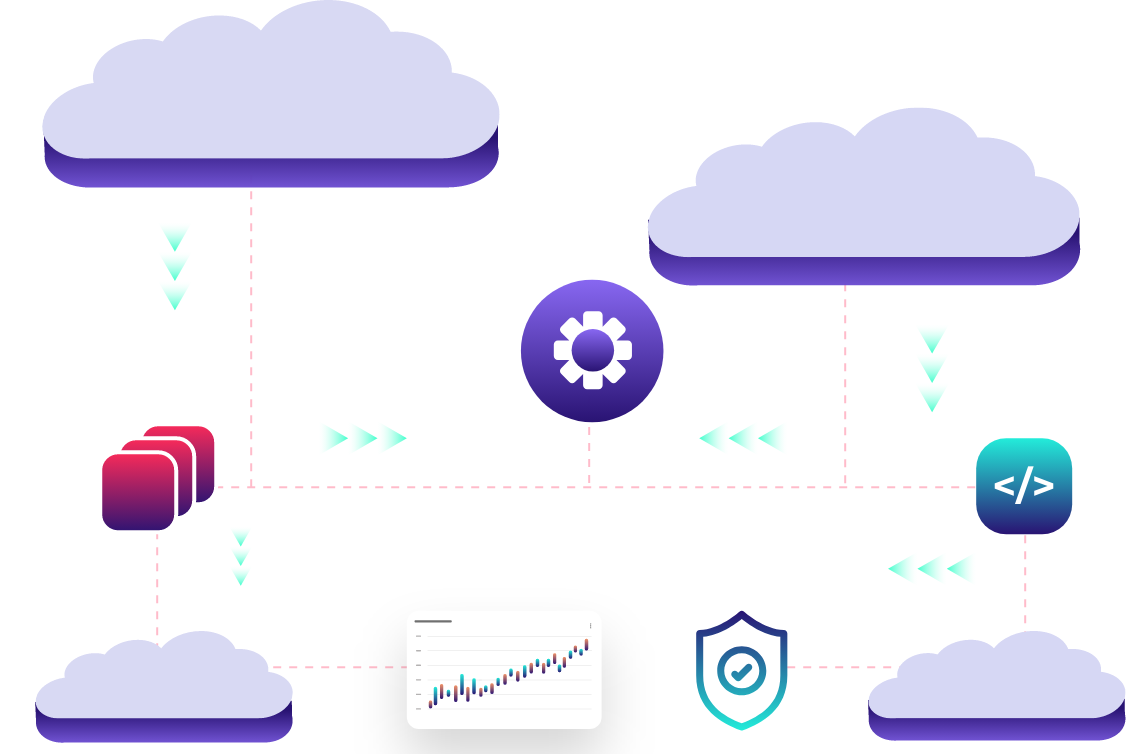Greatest Hits: The Smartest Applications of Cloud Computing
When more than 127 million fans simultaneously watched the 2025 Super Bowl, they weren’t thinking about the event-driven auto-scaling technology behind their viewing experience—whether it was on cable, streamed, or through digital antennas. But behind the scenes, cloud infrastructure was automatically scaling to handle the massive spike in viewership—adjusting bandwidth, processing power, and resources in real time to ensure every touchdown was broadcast without a hitch.
This is a perfect example of how cloud computing has evolved from simple data storage system solutions into a strategic powerhouse that shapes how modern businesses operate and compete.
While most organizations that use cloud computing get the basic benefits, its real potential goes way beyond just the basics. These days, cloud services help healthcare providers create personalized treatment plans using AI, enable financial institutions to process millions of secure transactions in seconds, and let gaming companies build immersive experiences that connect players around the globe. Here, we take a look at how businesses are using these advanced cloud tools to drive innovation, streamline operations, and stay ahead of the competition.
Cloud computing in the world around us
From hybrid cloud setups, file storage, and development tools to virtual machines, customer relationship management, and other cloud-based applications, cloud computing has become so deeply embedded in day-to-day operations that we often interact with it without even realizing. Businesses utilize cloud infrastructure to power everything from streaming services and online banking to real-time collaboration tools and AI-powered recommendations. This widespread use is not only convenient but also represents a major change in how businesses provide value to customers and run their operations.
Take, for instance, the way modern software applications handle peak loads. When millions of users simultaneously stream a major sporting event or participate in a viral social media moment, cloud infrastructure automatically scales to maintain performance. This same technology allows businesses to process thousands of transactions per second during sales events or manage sudden spikes in data processing demands.
Greatest hits: the top cloud computing applications in business

The benefits of cloud services have a huge impact on so many areas, but a few applications really stand out for how they’re transforming business applications and IT infrastructure. Let’s take a closer look at some of the best ways the cloud is changing how organizations work and compete.
Cost optimization: beyond basic cloud spending
Cloud cost optimization isn’t just about managing computing resources anymore. Now, it includes implementing smarter strategies (like placing workloads intelligently), scaling automatically based on real demand, and making the most of spot instances and reserved capacity. Many organizations even use machine learning to predict resource needs and adjust their infrastructure on the fly, avoiding both over-provisioning and performance headaches.
Adopting FinOps practices is becoming a must for keeping costs under control, especially when scaling can lead to sudden spikes in expenses. FinOps helps bring financial accountability to cloud spending by encouraging collaboration across teams. Its strategies through its framework lets organizations find the right balance between speed, quality, and cost-effectiveness when making decisions about their cloud architecture.
Here’s an example: Starchive, a digital asset management platform, struggled with skyrocketing cloud costs as its user base grew and it added AI-assisted features. Working with DoiT to roll out a solid cost optimization strategy—including automated resource management and detailed cost tracking—Starchive managed to cut its annual cloud spend by 32%. In addition to saving money, Starchive was able to make smarter decisions about how to allocate resources.
Operational efficiency through automation
Cloud-based automation has transformed operational efficiency, turning traditional workflows into streamlined, intelligent processes. When implemented strategically, cloud automation can dramatically improve both performance and cost efficiency.
HackerRank worked with DoiT to overcome build release pipeline challenges caused by rapid growth through cloud automation and modernization. It streamlined release cycles, sped up deployments with parallel testing, automated container management using Amazon Web Services (AWS) Fargate, and reduced EC2 costs by 24% with intelligent scaling.
Collaboration and remote work
The cloud has fundamentally transformed how teams collaborate and work remotely. Far beyond basic file sharing, modern cloud solutions address the full spectrum of collaboration needs, from daily operations to long-term business agility.
Magic Software Enterprises modernized its 15-year-old IBM Lotus Notes system by adopting cloud-based workplace tools.The transformation wasn’t just about new tools, though—it represented a strategic shift in how the company operated. As Alexandra Etush, IT Manager at Magic Software, noted: “Our employees can now collaborate using better applications, and our IT department spends less time maintaining servers and updating software.”
Enhanced security and compliance
Cloud security now surpasses traditional defenses with advanced features like AI-driven threat detection, automated compliance tools, zero-trust access controls, and seamless encryption management, ensuring robust, real-time protection.
However, the rise of multicloud strategies brings security challenges like inconsistent controls, complex identity management, visibility gaps, and compliance issues. Organizations need tools and strategies for unified security monitoring and policy enforcement across all platforms.
A financial services company, for instance, might use cloud security features to meet strict regulatory requirements while lightening the workload for its security team. Automated controls and detailed audit trails not only make compliance easier but also boost the overall security of the workloads.
AI/ML integration and deployment
The combination of AI, machine learning, and cloud computing is transforming how businesses operate.
3 industry-specific applications of cloud computing

Here are a few ways cloud computing is improving industries by providing customized solutions that tackle unique needs, challenges, and opportunities.
Healthcare: improving patient outcomes
Healthcare organizations use cloud computing to make patient care better by making data more accessible and easier to analyze. Take Candid, for example—an oral healthcare company that shows how cloud technology can boost both efficiency and patient outcomes.
By switching to DoiT’s cloud-based solutions, Candid was able to:
- Simplify dental record management with secure, long-term storage for patient data
- Use artificial intelligence (AI) automation to cut down case submission time by 1 to 5 minutes per patient
- Ensure efficient cloud storage that meets 8- to 10-year medical record retention requirements
- Integrate dental imaging systems with the cloud for smoother case processing
Fintech: enhancing security and compliance
Fintech companies are tapping into cloud service providers to tackle tricky regulatory requirements while offering innovative services. Taxfix, Europe’s top mobile tax app, worked with DoiT to handle sensitive financial data across multiple countries.
With its advanced cloud infrastructure, Taxfix delivers:
- Secure tax return processing with automated checks and data validation
- Compliance with tax laws in Germany, Italy, and Spain
- Scalable systems that have helped users claim over 2 billion euros in tax refunds
- Integration with government databases while keeping data security a top priority
Taxfix uses its cloud-based platform to simplify complicated tax systems, making them easy to navigate while following each country’s rules.
Gaming: delivering seamless multiplayer experiences
The gaming industry also uses cloud computing to offer unmatched scalability and performance. GoldenRace, a global leader in virtual sports betting that handles more than 25 million betting tickets daily, shows how cloud technology can power complex gaming operations while staying efficient.
With smart cloud strategies, GoldenRace achieves:
- Automated resource scaling that adjusts to global demand across 500+ websites
- Real-time betting transaction processing with reliable performance
- Multi-region infrastructure that meets various regulatory needs
- Advanced monitoring and analytics to catch issues before they happen
By fine-tuning its cloud setup, GoldenRace cut its cloud costs by 21% and boosted service reliability. Thanks to DoiT’s Anomaly Detection, GoldenRace can spot and fix potential problems early, ensuring a smooth experience for users on their virtual sports cloud platforms.
The role of cloud in driving innovation
Cloud computing continues to grow rapidly across industries and is expected to generate over $720 billion in revenue in 2025. Its flexibility and efficiency allow businesses to adapt quickly to a fast-changing digital world while cutting costs and maximizing impact. Here are some key areas where cloud is driving innovation:
Cloud-native AI/ML development
The cloud is unlocking the full potential of AI and machine learning:
- AI tools in development environments: Developers can easily add AI features to build smarter cloud applications.
- Scalable infrastructure: Train, test, and deploy large AI models with cloud resources that adjust to demand.
- Automated ML pipelines: Simplify workflows with tools to automate tasks and provide real-time updates.
Cloud-based R&D
Research and development can be a costly process, but the cloud has made it more accessible to businesses of all sizes with benefits like:
- Quick prototyping: Test ideas rapidly, speeding up the path from concept to execution.
- Faster product launches: Eliminate infrastructure delays to bring products to market quickly.
- Efficiency: Cloud-based tools allow for faster data processing, reducing the time needed for experiments.
- Flexibility: With no need to invest in expensive hardware or infrastructure, R&D teams can experiment freely without worrying about costs.
Serverless architecture
Serverless architecture simplifies app development and deployment:
- Automatic scaling: Workloads adjust dynamically to ensure smooth performance.
- Less complexity: Developers focus on coding instead of cloud server or physical server management.
- Flexible pricing: Pay-as-you-go services allow businesses to innovate without big financial risks.
Faster feature rollouts: Update apps quickly to meet user needs.
Common cloud adoption challenges and how to prepare

Successfully moving to the cloud takes careful planning and ongoing effort. Here’s how to tackle some key challenges effectively based on real-world cases:
Managing costs and avoiding overspending
To optimize cloud spending while maintaining business agility, organizations can learn from Simpool’s strategic approach to cost management.
Simpool achieved significant savings by implementing a structured cost optimization framework. By leveraging flexible discount programs like Savings Plans and implementing dynamic resource scaling, Simpool ensured efficient resource utilization based on workload demands. Additionally, managed services like DoiT’s Flexsave simplified cost optimization, enabling seamless financial management.
The impact is significant: Simpool achieved a 21% reduction in overall EC2 costs and a 23% decrease in on-demand spending without diverting resources from product development.
Staying on top of governance and compliance
To build a solid governance framework, organizations can learn from Optessa’s approach to achieving SOC2 compliance.
Optessa enhanced its cloud infrastructure by taking direct control of its production environment, ensuring compliance with strict security standards. With DoiT’s support, the company conducted audits, addressed identity and access management (IAM) permissions, and implemented secure access policies. The migration process included automated quality assurance to meet SOC2 requirements, along with team training and collaboration to align on security and compliance goals.
Scaling without losing performance
For businesses handling vast amounts of data, it’s essential to scale efficiently while maintaining performance. Huq, a leader in mobility data analytics, showcases how organizations can achieve this balance with a robust data platform.
Huq migrated to Google Cloud Platform and optimized its data pipeline with Apache Beam and Google Dataflow to handle nearly a billion geo-location records daily. With support from DoiT, Huq implemented Google Cloud Composer for workflow automation, BigQuery for fast analytics, and optimized cloud costs—cutting spending by 50% while quadrupling data processing capacity.
Managing and protecting your data
Keeping data secure, compliant, and well-governed is a top priority for any organization managing critical workloads in the cloud. Apex Networks, a leader in networking solutions for transportation and logistics, took its AWS environment to the next level by building a secure and well-governed infrastructure.
Apex Networks partnered with DoiT’s DevOps experts to enhance its data protection strategy by implementing a multi-account structure, automating compliance audits, strengthening security controls, and modernizing deployment processes. These improvements ensured ISO 27001 compliance (a standard in risk-based information security management compliance), reduced security risks, and streamlined infrastructure management in a scalable AWS environment.
Achieve cloud computing success
From software as a service (SaaS) companies and start-ups to ecommerce and business process–related use cases, adopting cloud computing services successfully means having a clear strategy that aligns with your business goals. Some key steps include evaluating your current infrastructure, planning a solid migration strategy, investing in the right training and tools, optimizing regularly with data, and working with cloud experts.
The cloud offers so much more than just basic infrastructure advancements and cost savings. By focusing on strategic applications and tackling common challenges head-on, DoiT helps businesses unlock real value and drive innovation through their own use of cloud environments.
Get The Cloud Compute Commitment Handbook to learn whether commitments might be a good way to save money on your public cloud workloads.


